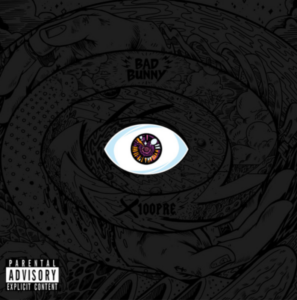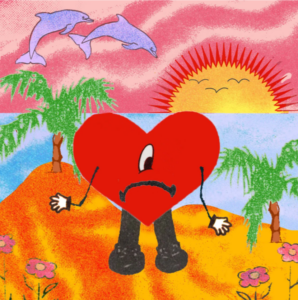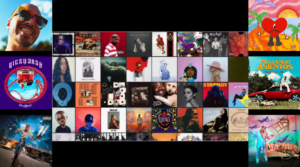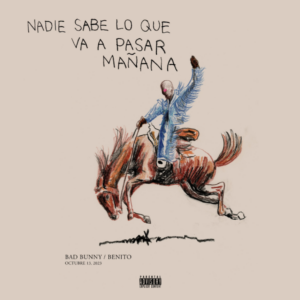There aren’t many images that thousands of people around the world could recognize within a glance. Through his album covers, though, Bad Bunny has produced multiple pieces of infamous art. What story are Bad Bunny’s album covers telling?
Album Covers as Narratives
Album covers have the ability to influence our listening experience in a reciprocal process, i.e. the cover of an album can affect how we interpret the music, and the music can impact how we visually conceptualize the art. The art historian W.J.T. Mitchell makes the argument that “there are no visual media,” but rather all media is intertwined. Albums are a prime example of this notion of mixed-media. Music is a fluid object, but an album cover provides physicality through visual art that takes the music beyond an abstract representation.
In his article, “The Narrative Potential of Album Covers,” Robert J. Belton argues that pictures are capable of inducing narratives by stimulating people’s hyperactive imaginations to develop stories. Therefore, album covers can create narratives that “exist outside the picture” as an independent interpretation of the art.
By looking at Benito’s album covers, one can form an understanding of the different worlds he creates with each album and the larger story that he’s telling through the evolution of these albums’ art.
x100pre
The album cover x100pre for x100pre is deceivingly simplistic; on a first glance, the album is just an eye on top of a black background. In actuality, this black background is a drawing of two tattooed arms (presumably Benito’s) wrapped around each other. The spiral shape formed by the arms is reminiscent of the swirls of a hurricane, implying that Benito’s third eye in the center symbolizes the literal eye of a hurricane.

x100pre (2018) by Bad Bunny
This of course brings to mind the devastating Hurricane Maria that hit Puerto Rico in late 2017. Benito has talked about the impact of Maria on himself, his family, and all of Puerto Rico throughout the entirety of his career. By 2018, when x100pre was released, the Puerto Rican government estimated that 2,975 people passed away as a result of the hurricane. The dark colors and the reference to Hurricane Maria on this album cover establish a somber mood. It is worth noting, however, that the arms are wrapped around each other like a warm hug. Thus, one can form the conclusion that x100pre is an ode to Puerto Rico, both in mourning and through love.
YHLQMDLG
The album cover art for YHLQMDLG (an acronym for Yo Hago Lo Que Me Da La Gana) takes a hard turn from the simplicity of the x100pre cover. The cover for YHLQMDLG centers on a little boy with a third eye, presumably Benito, but there is a lot happening in the background. Belton makes the argument that art is not static, but rather situated in time because time is required to view pictures and truly interpret them. Belton cites a study by himself and Kersten that empirically demonstrates with eye-tracking devices that people’s eyes take time to trace pictures. So what do our eyes see as we scan this album cover? The dark clouds brewing in the sky and the car (and a cow in the distance) flying through the air are recollective of the destructive effects of a hurricane. The exploding electrical pole on the left side of the album cover is likely a reference to the ongoing power outages in Puerto Rico, both caused by the long-lasting effects of Hurricane Maria and by the privatization of electrical production.

YHLQMDLG (2020) by Bad Bunny
The child running away from this impending hurricane might suggest that Bad Bunny was establishing a narrative of escapism. But, we don’t know where exactly this little kid is biking to. In the summer of 2019 (the summer before the release of YHLQMDLG), protests erupted in Puerto Rico after the Rossello administration’s corruption was exposed through a series of incredibly tone-deaf and offensive group chat messages that were leaked to the public. Benito decided to pause his European tour to join the protests, and even encouraged others to make their voices heard. He also released the song “Afilando Los Cuchillos” with Residente, and iLe addressing the government corruption in Puerto Rico. One can therefore assume that the little Benito on the cover of YHLQMDLG is actually running to his family and friends, similar to how Benito returned to Puerto Rico during a time of crisis.
Un Verano Sin Ti
For the album cover of Un Verano Sin Ti, Bad Bunny worked with his long-time partner, Ugly Primo (aka Adrian Hernandez). Hernandez has previously stated that as a Mexican-American artist, his mission is to represent Latino culture through his art. Benito’s decision to have Adrian design the art for this album feels very intentional considering that musically, Un Verano Sin Ti is a tribute to sounds from across the Latino diaspora. A variety of Latino music genres are present in this album, such as merengue (“Después de la Playa”) and dembow (“Tití Me Preguntó”).

Un Verano Sin Ti (2022) by Bad Bunny
The colorful cover art for Un Verano Sin , with palm trees, a shining sun and jumping dolphins, creates the impression of a happy, celebratory album that includes fun, party tracks. In this instance, one can apply Nathan Zed’s theory of color analysis that he discusses in his Youtube video “The Power of Album Covers.” Nathan argues that color is one of the most important parts of creating an album cover, stating that “every song has a feeling that is associated with a color” and an album cover can reflect that. He provides the example of American music in 2016. The music from this era was primarily fun and upbeat, which was reflected by a trend of colorful album covers. A comparison can be drawn to reggaeton albums from the time Un Verano Sin Ti was released. From 2019 to 2022, reggaeton album covers were very colorful, which matched the carefree feeling of a lot of reggaeton music at the time. This provides further evidence that Un Verano Sin Ti is a happy album.

Center: Compilation of 2016 American album covers screenshotted from “The Power of Album Covers” video, Sides: Reggaeton album covers from 2019-2022
However, the colorful backdrop of the Un Verano Sin Ti cover is misleading. If you look carefully, you’ll notice that the heart in the center of the album is actually frowning. This corresponds with Benito’s own feelings about his album, which he explained to be more somber than others might think. In fact, there are several sad love songs on the album. “Un Coco,” “Un Verano Sin Ti,” and “Yo No Soy Celoso” are just a few of the many breakup songs on the album that are deceivingly upbeat despite the depressing lyrics. This album cover is therefore a reflection of the music in the album. The bright colors in the cover art are a distraction from the sad heart, similarly to how the cheerful melodies take attention away from the unhappy love songs.
Nadie Sabe Lo Que Va A Pasar Mañana
The album cover for Nadie Sabe Lo Que Va A Pasar Mañana reflects a significant departure in design from Bad Bunny’s previous albums. For this cover art, Benito worked with the Washington-based contemporary artist Matt McCormick, who is known for his drawings and paintings of iconography from the American West which frequently reference cowboys. This album cover, a beige background with a cowboy and some text, is more simplistic than those previously discussed. It’s possible that Benito chose to have a simpler background to highlight the album title, which is much more prominent than in any of his other album covers. He also chose to have his name written on the album cover as Bad Bunny/Benito. This is the first time he includes his government name on an album.

Nadie Sabe Lo Que Va A Pasar Mañana (2023) by Bad Bunny
Such a significant departure from his other cover art corresponds with accusations that Benito began to distance himself from his Latino roots. In early 2023, Benito started dating Kendall Jenner. In May of 2023, he released the jersey club song “Where She Goes,” which was a rare instance of Bad Bunny having a song title in English. In May of 2024, he co-chaired the Met Gala. Benito’s fans began to question his increasinging connection to the English-speaking world, often claiming that he was being white-washed. It could be argued that Benito’s decision to work with an American artist instead of his long time friend Ugly Primo is evidence of his Americanization. However, his choice to have an album cover with a simplistic background suggests Benito wanted to draw attention not only to the album title, but to his legal name as well. This album is evidence of Benito exploring his identity in a new way and understanding where he fits into the world of superstardom that he has entered.
Conclusion
Bad Bunny’s album cover art reflects what’s happening in his various “lives,” including his home in Puerto Rico, his personal life, and the larger world of Latino music. Benito creates new worlds with each album that capture different aspects of his identity by using artistic techniques and references to contemporary events. The album covers of x100pre, YHLQMDLG, Un Verano Sin Ti, and Nadie Sabe Lo Que Va A Pasar Mañana stimulate our imaginations to find deeper meaning in their art, as well as push us to interpret the music of these albums in a different way. Continuing to analyze albums through their cover art can help us better understand the cultural, social, and political implications of an artist’s work. We’re left to wonder what Bad Bunny’s future album covers will look like. Does Benito’s deeper exploration of his identity imply that his values as an artist have changed? How can we aim to critique his album covers while continuing to appreciate his art?
Bibliography
Belton, Robert J. “The Narrative Potential of Album Covers.” Studies in Visual Arts and Communication: an international journal 2, no. 2 (2015).
Chavez, Nicole. “Private Leaked Texts, Massive Protests and a Governor’s Downfall: A Timeline of Puerto Rico’s Political Unrest.” CNN, July 28, 2019. https://www.cnn.com/2019/07/27/us/puerto-rico-governor-scandal-timeline/index.html.
Fink, Sheri. “Nearly a Year after Hurricane Maria, Puerto Rico Revises Death Toll to 2,975.” The New York Times, August 28, 2018. https://www.nytimes.com/2018/08/28/us/puerto-rico-hurricane-maria-deaths.html.
Flores, Antonio, and Jens Manuel Krogstad. “Puerto Rico’s Population Declined Sharply after Hurricanes Maria and Irma.” Pew Research Center, July 26, 2019.
Laughland, Oliver. “‘Ricky, Resign!’ Puerto Rico’s Famous Musicians Lend Voice to Surging Protesters.” The Guardian, July 21, 2019. https://www.theguardian.com/world/2019/jul/21/puerto-rico-ricky-martin-bad-bunny-protest-governor.
“Meet Ugly Primo – Voyage LA Magazine | La City Guide.” Voyage LA, March 19, 2019. https://voyagela.com/interview/meet-ugly-primo-ugly-primo-los-angeles/.
“Matt McCormick – Artworks for Sale & More | Artsy.” Artsy. Accessed December 14, 2024. https://www.artsy.net/artist/matt-mccormick.
Roiz, Jessica. “How Ugly Primo Brought Bad Bunny’s ‘Un Verano Sin Ti’ Album Cover to Life.” Billboard, June 2, 2022. https://www.billboard.com/music/latin/bad-bunny-album-cover-ugly-primo-interview-1235080469/.
Vad, Mikkel. “The Album Cover.” Journal of Popular Music Studies 33, no. 3 (September 2021).
Zed, Nathan. “The Power of Album Covers.” YouTube, 2020. https://www.youtube.com/watch?v=r2WKdTnNE44.
